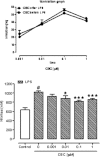The cannabinoid TRPA1 agonist cannabichromene inhibits nitric oxide production in macrophages and ameliorates murine colitis
- PMID: 23373571
- PMCID: PMC3632250
- DOI: 10.1111/bph.12120
The cannabinoid TRPA1 agonist cannabichromene inhibits nitric oxide production in macrophages and ameliorates murine colitis
Abstract
Background and purpose: The non-psychotropic cannabinoid cannabichromene is known to activate the transient receptor potential ankyrin-type1 (TRPA1) and to inhibit endocannabinoid inactivation, both of which are involved in inflammatory processes. We examined here the effects of this phytocannabinoid on peritoneal macrophages and its efficacy in an experimental model of colitis.
Experimental approach: Murine peritoneal macrophages were activated in vitro by LPS. Nitrite levels were measured using a fluorescent assay; inducible nitric oxide (iNOS), cyclooxygenase-2 (COX-2) and cannabinoid (CB1 and CB2 ) receptors were analysed by RT-PCR (and/or Western blot analysis); colitis was induced by dinitrobenzene sulphonic acid (DNBS). Endocannabinoid (anandamide and 2-arachidonoylglycerol), palmitoylethanolamide and oleoylethanolamide levels were measured by liquid chromatography-mass spectrometry. Colonic inflammation was assessed by evaluating the myeloperoxidase activity as well as by histology and immunohistochemistry.
Key results: LPS caused a significant production of nitrites, associated to up-regulation of anandamide, iNOS, COX-2, CB1 receptors and down-regulation of CB2 receptors mRNA expression. Cannabichromene significantly reduced LPS-stimulated nitrite levels, and its effect was mimicked by cannabinoid receptor and TRPA1 agonists (carvacrol and cinnamaldehyde) and enhanced by CB1 receptor antagonists. LPS-induced anandamide, iNOS, COX-2 and cannabinoid receptor changes were not significantly modified by cannabichromene, which, however, increased oleoylethanolamide levels. In vivo, cannabichromene ameliorated DNBS-induced colonic inflammation, as revealed by histology, immunohistochemistry and myeloperoxidase activity.
Conclusion and implications: Cannabichromene exerts anti-inflammatory actions in activated macrophages - with tonic CB1 cannabinoid signalling being negatively coupled to this effect - and ameliorates experimental murine colitis.
© 2013 The Authors. British Journal of Pharmacology © 2013 The British Pharmacological Society.
Figures











Similar articles
-
Pure Δ9-tetrahydrocannabivarin and a Cannabis sativa extract with high content in Δ9-tetrahydrocannabivarin inhibit nitrite production in murine peritoneal macrophages.Pharmacol Res. 2016 Nov;113(Pt A):199-208. doi: 10.1016/j.phrs.2016.07.045. Epub 2016 Aug 3. Pharmacol Res. 2016. PMID: 27498155
-
Inhibitory effect of cannabichromene, a major non-psychotropic cannabinoid extracted from Cannabis sativa, on inflammation-induced hypermotility in mice.Br J Pharmacol. 2012 Jun;166(4):1444-60. doi: 10.1111/j.1476-5381.2012.01879.x. Br J Pharmacol. 2012. PMID: 22300105 Free PMC article.
-
Beneficial effect of the non-psychotropic plant cannabinoid cannabigerol on experimental inflammatory bowel disease.Biochem Pharmacol. 2013 May 1;85(9):1306-16. doi: 10.1016/j.bcp.2013.01.017. Epub 2013 Feb 12. Biochem Pharmacol. 2013. PMID: 23415610
-
Palmitoylethanolamide, a naturally occurring lipid, is an orally effective intestinal anti-inflammatory agent.Br J Pharmacol. 2015 Jan;172(1):142-58. doi: 10.1111/bph.12907. Epub 2014 Dec 1. Br J Pharmacol. 2015. PMID: 25205418 Free PMC article.
-
Pharmacological actions of cannabinoids.Handb Exp Pharmacol. 2005;(168):1-51. doi: 10.1007/3-540-26573-2_1. Handb Exp Pharmacol. 2005. PMID: 16596770 Review.
Cited by
-
Antinociceptive Effects of Cannabichromene (CBC) in Mice: Insights from von Frey, Tail-Flick, Formalin, and Acetone Tests.Biomedicines. 2023 Dec 29;12(1):83. doi: 10.3390/biomedicines12010083. Biomedicines. 2023. PMID: 38255191 Free PMC article.
-
Decoding the Postulated Entourage Effect of Medicinal Cannabis: What It Is and What It Isn't.Biomedicines. 2023 Aug 21;11(8):2323. doi: 10.3390/biomedicines11082323. Biomedicines. 2023. PMID: 37626819 Free PMC article. Review.
-
Transient receptor potential (TRP) channels: a clinical perspective.Br J Pharmacol. 2014 May;171(10):2474-507. doi: 10.1111/bph.12414. Br J Pharmacol. 2014. PMID: 24102319 Free PMC article. Review.
-
Manipulation of the Endocannabinoid System in Colitis: A Comprehensive Review.Inflamm Bowel Dis. 2017 Feb;23(2):192-199. doi: 10.1097/MIB.0000000000001004. Inflamm Bowel Dis. 2017. PMID: 28079617 Free PMC article. Review.
-
The Potential of Cannabichromene (CBC) as a Therapeutic Agent.J Pharmacol Exp Ther. 2024 Oct 18;391(2):206-213. doi: 10.1124/jpet.124.002166. J Pharmacol Exp Ther. 2024. PMID: 38777605 Free PMC article. Review.
References
-
- Alhouayek M, Muccioli GG. The endocannabinoid system in inflammatory bowel diseases: from pathophysiology to therapeutic opportunity. Trends Mol Med. 2012;18:615–625. - PubMed
-
- Aviello G, Borrelli F, Guida F, Romano B, Lewellyn K, De Chiaro M, et al. Ultrapotent effects of salvinorin A, a hallucinogenic compound from Salvia divinorum, on LPS-stimulated murine macrophages and its anti-inflammatory action in vivo. J Mol Med (Berl) 2011;89:891–902. - PubMed
-
- Aviello G, Romano B, Borrelli F, Capasso R, Gallo L, Piscitelli F, et al. Chemopreventive effect of the non-psychotropic phytocannabinoid cannabidiol on experimental colon cancer. J Mol Med (Berl) 2012;90:925–934. - PubMed
MeSH terms
Substances
LinkOut - more resources
Full Text Sources
Other Literature Sources
Research Materials

